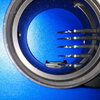Not possible, or not simply and reliably anyway.
A white LED will need over 3V; typically 3.2 to 3.6V dependant on type and current.
Also, a 2032 can give next to no sustained current; try and take more than a few mA and the voltage will just drop off.
You need a higher voltage, ideally around 5 - 6V, or a higher power battery and a switch mode power supply to boost the voltage.
With appropriate power, you could use a single transistor current source (or current sink) circuit.
The circuit below is a simple constant current sink.
To make it adjustable, replace R1 and R2 with a resistor from positive (top connection and two signal diodes such as 1N4148 in series to 0V (bottom connection).
The resistor value depends on the supply voltage; use a value that gives a minimum 10mA through the diodes with a near flat battery.
Add the potentiometer (100 Ohms) across the upper of the two diodes and connect the transistor base to the pot wiper.
That gives a variable bias from roughly 0.6V to 1.2V for the base.
The LED would connect in the "Load" position and make Re a suitable value so around 0.6V across it gives the highest LED current you need; eg 20 Ohms would give roughly 30mA maximum.




